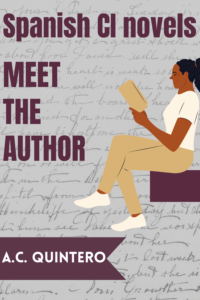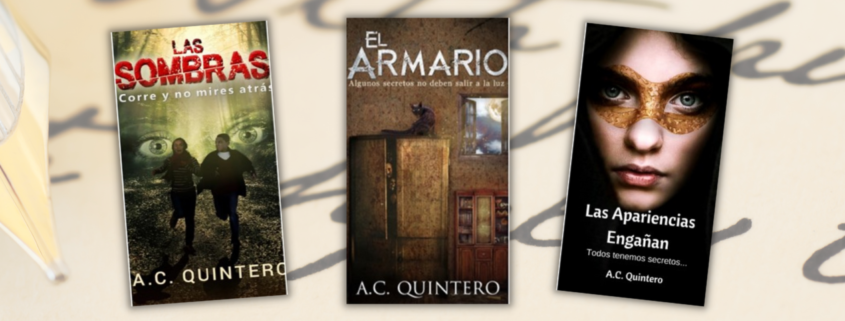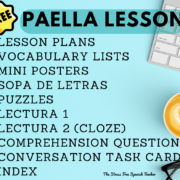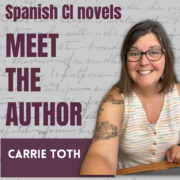Meet CI Author A.C. Quintero
/in Uncategorized/by adminDo your middle school and high school Spanish students LOVE readings with a bit of mystery?
You will definitely want to get to know the author, A. C. Quintero, author of fifteen Spanish readers (and counting!) that are perfect for your Spanish class FVR Library!
I asked Profesora Quintero few questions to get to know her and her inspiration as an author. Read on to get to know Ms. Quintero and her work too!

With titles like, ‘Las Apariencias Engañan,’ ‘El Escape,’ and ‘La Pasajera Misteriosa,’ it’s no wonder students LOVE her books!
Profesora Quintero has graciously gifted us six of her readers to give away during our 2023 ‘Spanish Teachers LOVE to Read’ giveaway to help you grow your Spanish class Free Voluntary Reading Library! (ENTER THE GIVEAWAY HERE!)
1. La Clase de Confesiones – Level 1 Spanish
Themes: Relationships, school life, adolescent life, friendship, first love, school crushes
2. Feliz Cumpleaños – Level 1 Spanish
Themes: Birthdays, relationships, school life,dealing with bullies, sports, adolescent life, friendships, overcoming fear, believing in oneself
3. La Obsesión Digital – Level 2 Spanish
Themes: Family relationships, food, relationship, technology, and cellphone addiction, intergenerational relationships
4. La Pasajera Misteriosa – Level 2 Spanish
Themes: Family, divorce, recovery, anger-management, finding friendship, personal growth, sports, travel
5. Las apariencias Engañan – Level 3+ Spanish
Themes: Relationships, betrayal, secrets, keeping appearances, school life, bickering teens
6. El Escape – Level 3+ Spanish
Themes: Technology addiction, decisions, teen life, crime thriller

1. Have you always wanted to be an author?
I never really considered myself an author/writer, but I did notice my knack for storytelling as a highschooler. When we’d go to Mississippi for summer vacation, I’d hypnotize my cousins with stories from Chicago about the school, kids, relationships; basically, whatever made them laugh. I remember being aware of how to capture my audience, pacing the story, and prepping ford the punchline.
Furthermore, during my senior year of highschool, I had a commitment group of friends who’d ask me to cheer them up with one of my famous stories. It was usually about some wacky date I had gone on. There was a story in particular that became one of my greatest hits: the guy in the banana-colored car. Earlier that year, I had gone out on a date with a guy from my cousin’s neighborhood (she had introduced us). After months of talking on the phone (no texting back then, but I did have a beeper!), he and I had agreed to meet up near a pizzeria. As I approached the banana-colored car, I noticed that he had brought his mother and sister along. The date was literally being chaperoned! It was so wild. He was probably 17 with a car. I was 16, so it was the source of a lot of laughter. I believe that my storytelling skills were honed during this time, and it’s perhaps my best tool in the powerbelt for teaching. We never finish a lesson on time because I am always telling some funny story.
2. When / why did you first start writing Spanish language books?
I started writing books in Spanish approximately 5 years ago. In fact, the first book I wrote was Cómo salir de la zona de Amigos, but not the first one published. At the time, there was a sheer lack of representative characters and narratives. I live and work in Chicago, and I remember reading some CI books and not really feeling a personal connection, even though they were comprehensible. My opportunity to write actually came when I had a really interesting class. What I was doing wasn’t working, so I decided to create “La clase de confesiones” to highlight the vocabulary and structures I wanted them to acquire. When I saw their reaction to the story it made me feel like I had reached them on some level. I worked arduously to learn how I could publish the book so other students would have a great experience reading.
My mission from then on was to write books with a wide range of characters with a variety of experience- and not just the stereotypical drama. This is precisely what I have tried to do with book such as La clase de confesiones, La bella mentira, El último viaje (all of which feature Black and Afrolatinx characters, which was very scarce at the time I started writing).
3. What, to you, are the most important elements of a good Spanish language book for 2nd language acquisition?
From my own experience it is compelling high interest content that facilitates acquisition while reading. This has also been corroborated by research. When we read or listen to content that is compelling, it’s easier for acquisition to take root.
Secondly, the content should have some type of personal connection. It has to connect to the lives of the students. This is one of the reasons why so many of my books take place in settings that are familiar to students (school, neighborhood, classroom), and the topics connect to their lives. Who doesn’t have a school crush, like Carlos Solis en La clase de confesiones? Who hasn’t made an unwise decision about uploading a silly prank or something they’d come to regret on social media, as the boy in the novel El escape? Who hasn’t felt the pressure of making extremely agonizing choices, such as Valeria, in El último viaje? Who’s day hasn’t been totally derailed by a text message, like Adán in El mensaje. And lastly, who doesn’t like a juicy (but appropriate) tale of betrayal similar to the unearthed secrets in Las apariencias?
These stories resonate with students because they feel the joy, the pain, the hurt, and suspicion of the characters; it’s very real for them. Lastly, making sure the book is comprehensible adds enormously to the equation, however, I also think that interest does outweigh comprehensibility on some levels. I have seen this in my class at times where students would choose a book like El escape, they’d read, and get so hooked that they’d flip back and forth from the glossary. I even had some of my Spanish IV students challenge themselves to read La Casa en Mango during Free Voluntary Reading. I used to read Andrew Weil’s books in Spanish, and because I was very interested in the topic of health, I would look up words. That is not ideal for a classroom setting, but students who are quite taken by a story that is more will go the extra mile regardless of level.
4. Which of your characters do you relate to the most? Why?
First off, I love this question! I mostly relate to Carlos Solis from the series “La clase de confesiones.” Truth be told, many of the embarrassing events in the book constituted my middle school and high school experience. Most of the teachers in both La clase de confesiones and its sequel La bella mentira (my favorite book!) are based on real teachers- even the ones that end up dating (spoiler alert). On a positive note,Carlos walks to fire, his character is put on trial, but he prevails in the end; my real life crush rejected me freshman year. Years later, when the tables were turned, he tried to rekindle that flame; but that wick had burned its last string. “Buddy, you had your chance!”
5. What kinds of books do you like to read?
I love to read biographies, historical fiction, and books about the Black or Afro-Latinx experiences. I am reading “Indómita” by the Afro-Boricua writer Dalma LLanos-Figueroa. I have an ongoing blog post with my favorite books:
https://wordpress.com/post/acquinterobooks.wordpress.com/1199
6. Describe your ideal writing space / atmosphere. How do you prepare to write? (Do you go to a specific room of your house? Grab a cup of coffee/tea? Go to Starbucks or the library?)
I love writing in coffee shops! I found this new one near my house. I usually listen to one of the Youtube mixes below, and I work.
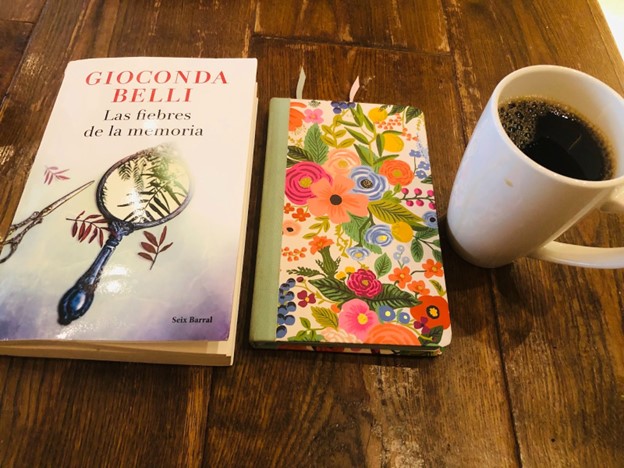
Profeosra Quintero’s reading, writing, and coffee space. ☺️
Connect with Profesora Quintero around the internet:
 Twitter: @klasekastellano
Twitter: @klasekastellano
 Instagram: @a.c.quintero
Instagram: @a.c.quintero
 Blog: https://acquinterobooks.wordpress.com/
Blog: https://acquinterobooks.wordpress.com/
 Facebook Group: CLICK HERE
Facebook Group: CLICK HERE

